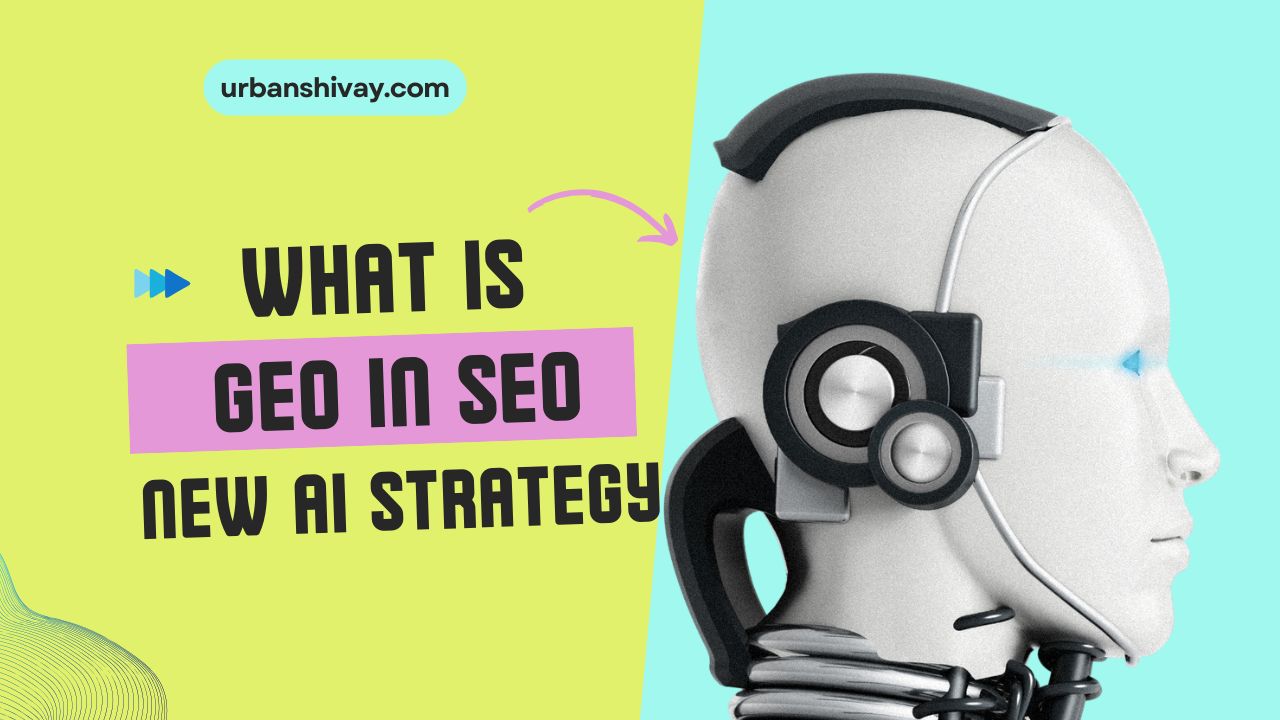What is Generative Engine Optimization (GEO) in digital marketing? If you are searching for this, then you are in the right place.

The digital landscape is constantly shifting every day and every month. For years, Search Engine Optimization (SEO) has been the basis of online visibility, focusing on getting your website to rank high in search engine results pages (SERPs).
But with the rise of generative AI models like ChatGPT, Gemini, and Google’s AI Overviews, a new parameter is emerging known as Generative Engine Optimization (GEO).
With AI models like ChatGPT, Gemini, or other platforms, users are no longer interested in just clicking links and navigating websites one by one to get info. Now they’re asking conversational questions of AI models and receiving direct, simple answers from them.
If your brand or website isn’t optimized for the new AI platforms’ results, you are at risk of being invisible in the new AI platforms, where millions of users are seeking information.
What Exactly is Generative Engine Optimization (GEO)?
While traditional SEO aims to bring users to your website by ranking it in search results, GEO is about ensuring your website content is accurately represented, cited, and effectively distributed within the responses generated by AI platforms.
It’s about optimizing your content not just for search engine algorithms, but also for the large language models (LLMs), which means AI platforms like ChatGPT, Gemini, etc.
In a simple way:
- Traditional SEO: Focuses on keywords, backlinks, and technical SEO elements to get your website listed at the top of Google.
- Generative GEO: Focuses on clarity, authority, structured content, and context to ensure your content is used as a source and accurately summarized in AI-generated answers.
The core difference lies in the output. Traditional search engines provide a list of links; generative engines provide a direct, often concise, answer to user enquiries.

Your goal with GEO is to be the authoritative source from which that AI answer is derived.
Why is GEO a new strategy to generate traffic?
- Direct Answers, Less Clicking: Users are increasingly getting their answers directly from AI platforms like ChatGPT, Gemini, and others, bypassing the traditional SERPs of Google. If your content isn’t influencing these AI answers, your brand’s visibility diminishes, or you will lose a new traffic source for your website.
- Brand Authority & Trust: When an AI model cites your brand or uses your information in its response, it builds immense authority and trust with the user. You become a credible source that makes a good impression on the minds of AI users.
- Future-Proofing Your Strategy: As AI platform users grow and the number of users increases day by day, the importance of GEO is also increasing. Adapting now positions your brand or website for long-term success.
- Enhanced User Experience: AI prioritizes clear, concise, and authoritative information. By optimizing for GEO, you naturally improve the overall quality and user-friendliness of your content with AI platforms.
- New Competitive Advantage: GEO is still evolving, offering early adopters a significant opportunity to gain a lead on competitors with more traffic.
How to Implement Generative Engine Optimization (GEO)
Implementing GEO isn’t about abandoning your SEO efforts; it’s about expanding and refining them and adding something new as a strategic advantage. Here’s a practical guide:
- Understand Generative AI’s Priorities for choosing you & User Intent
- Conversational, Clear, Comprehensive: AI models excel at understanding natural language queries. Your content should be written in a conversational tone, be easy to understand, and cover topics comprehensively.
- Answer Questions Directly: AI models are designed to answer questions. Structure your content to directly address common user queries in a clear, concise manner. Think about the “who, what, when, where, why, and how” of your topics.
- Identify Prompt Patterns: Analyze the types of questions and prompts users are feeding into generative AI. Generally, I have seen long-tail keywords in questions and answers, that is mostly used in generative content of AI. Tools like “People Also Ask” in Google, or even experimenting with AI chatbots yourself, can reveal common inquiry patterns.
- Create High-Quality, Authoritative, and Fact-Based Content
- E-E-A-T (Experience, Expertise, Authoritativeness, Trustworthiness): This principle, crucial for traditional SEO, is even more vital for SEO. AI models prioritize content from credible sources.
- Experience: Share real-world experiences, case studies, and anecdotes.
- Expertise: Have subject matter experts create or review your content. Include author bios that highlight their qualifications.
- Authoritativeness: Build a strong reputation in your industry.
- Trustworthiness: Provide accurate, fact-checked information.
- Cite Your Sources: If you’re referencing data, statistics, or research, cite credible sources of other websites from which you have taken the data. This signals to AI that your information is well-supported and trustworthy.
- Incorporate Quotes & Statistics: AI models often pull out specific facts and figures. Make these easy to identify and extract by presenting them clearly.
- Original Research: If possible, conduct and publish your original research. This positions you as a unique and highly authoritative source.
- Structure Your Content for AI Readability
- Clear Headings and Subheadings (H1, H2, H3): Use descriptive headings that clearly outline the content. This helps AI models quickly grasp the structure and key points. Try to use or implement it as a question-and-answer format.
- Bullet Points and Numbered Lists: Break down complex information into easily digestible lists that is easy to read and understand. AI often uses these formats for summarized answers.
- Concise Paragraphs: Avoid long paragraphs of informational text. Short, focused paragraphs are easier for AI to process and summarize.
- FAQs Sections: Create dedicated FAQ sections that directly answer common questions. This format is perfect for AI to pull data from your website.
- Schema Markup: Implement schema markup (structured data) to tell search engines and AI models exactly what your content is about. Use specific schema types like FAQ Page, How to, Product, and Organization to provide clear signals for AI platforms and also for Google.
- Emphasize Brand Mentions and Entity Recognition
- Consistent Brand Messaging: Ensure your brand name, products, services, and core messaging are consistent across all your online properties or pages of your website.
- Develop a Strong Brand Voice: A unique and consistent brand voice helps AI models recognize and attribute content to your brand or website.
- Encourage Brand Citations: The more your brand is mentioned and cited by other reputable sources, the stronger your authority signals to AI. This includes press mentions, guest posts, and industry partnerships, which means SEO work is also important for your website to get traffic from AI platforms.
- Diversify Content Formats
- Beyond Text: Generative AI isn’t just about text. Optimize for multimodal content.
- Video Transcripts: Provide accurate and clear transcripts for all your video content.
- Image Alt Text & Descriptions: Use descriptive alt text and captions for images, incorporating relevant keywords.
- Infographics & Data Visualizations: Create visual content that presents information clearly and concisely. AI can extract data from these elements to produce the given results.
- Monitor, Analyze, and Iterate
- Track AI Mentions: While specific metrics for GEO are still developing, actively monitor when your brand or content is cited or summarized by generative AI outputs.
- Analyze AI Responses: See how AI models are answering questions related to your industry. Are they citing your competitors? What kind of information are they prioritizing? Use these insights to refine your content.
- Experiment Continuously: GEO is a new field. Test different content structures, formats, ask different kinds of questions, and approaches. Learn from what works and adapt your strategy.
GEO and SEO: A Symbiotic Relationship
It’s crucial to understand that GEO isn’t replacing SEO. Instead, it’s an evolution in SEO as a new strategy. A strong traditional SEO foundation – including technical SEO, page speed, mobile-friendliness, and a good backlink profile – still plays a vital role in ranking and generating traffic.

Generative engines still crawl and index the web content, and they rely on well-optimized content to give it as a source of information to users. So, make the best content in question-and-answer format and get more traffic. To get more updates, visit us.


Leave a Reply